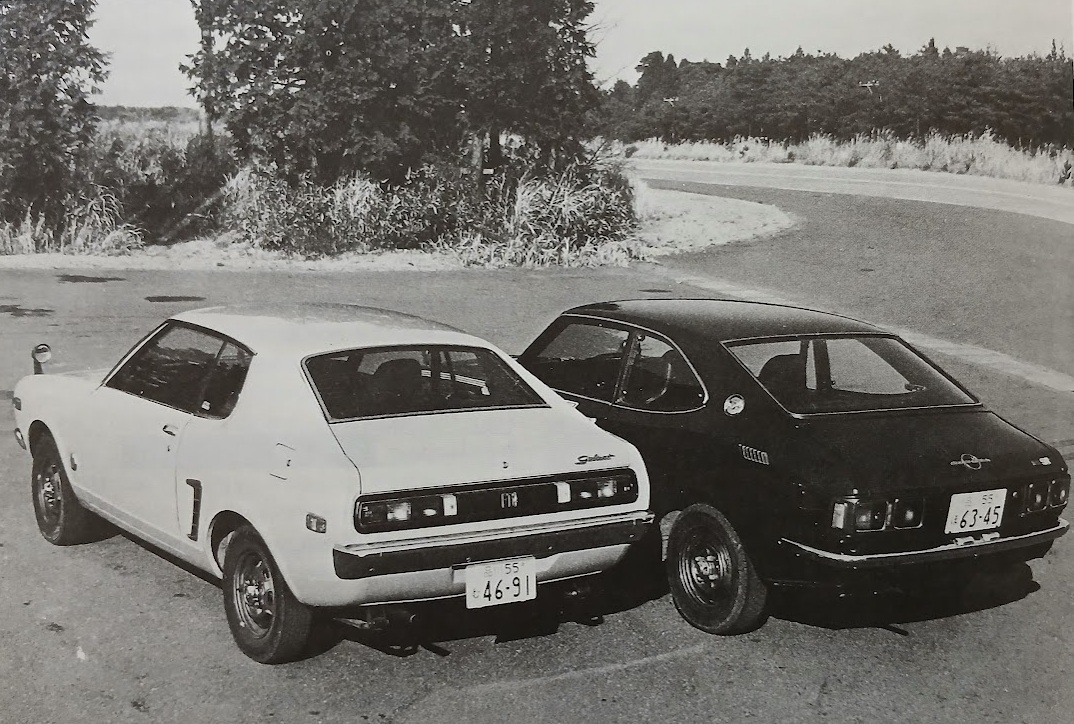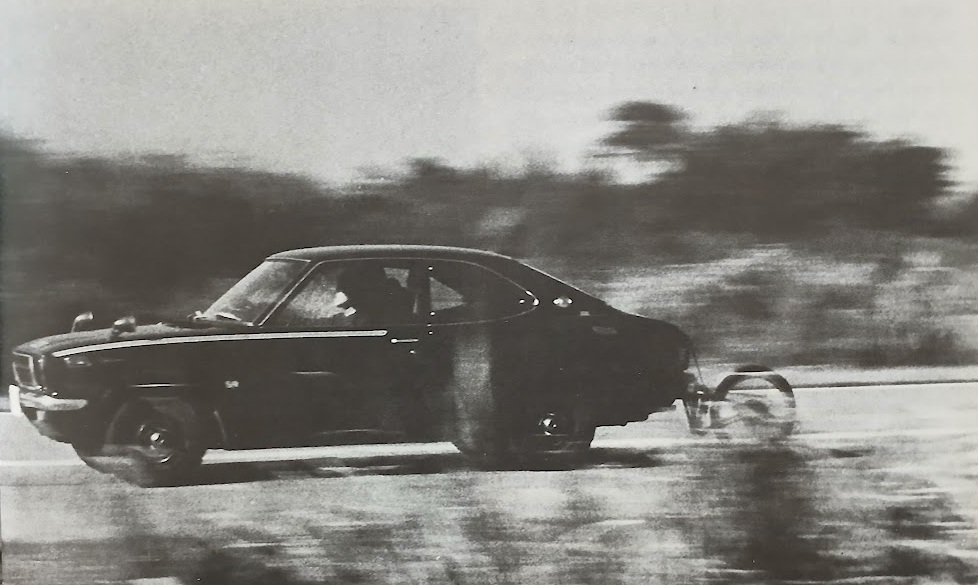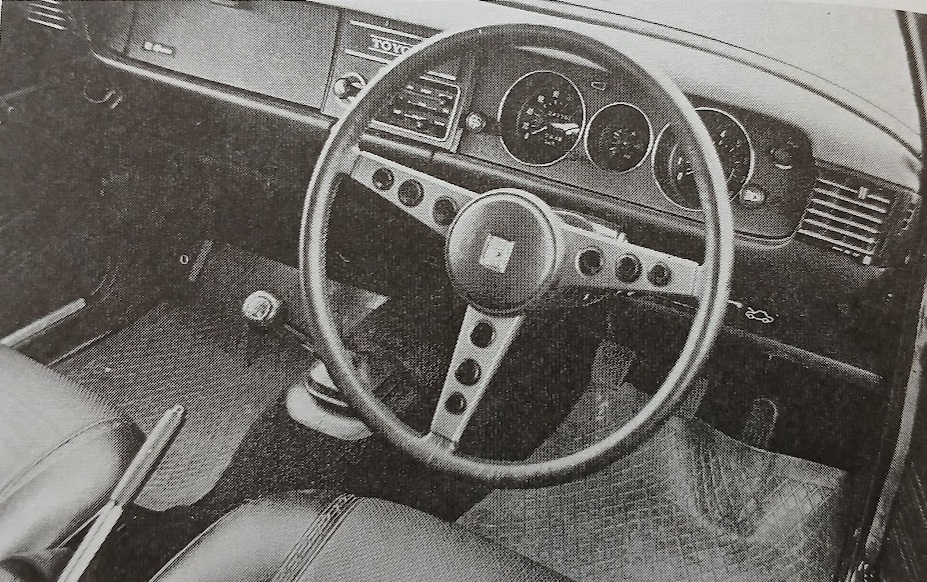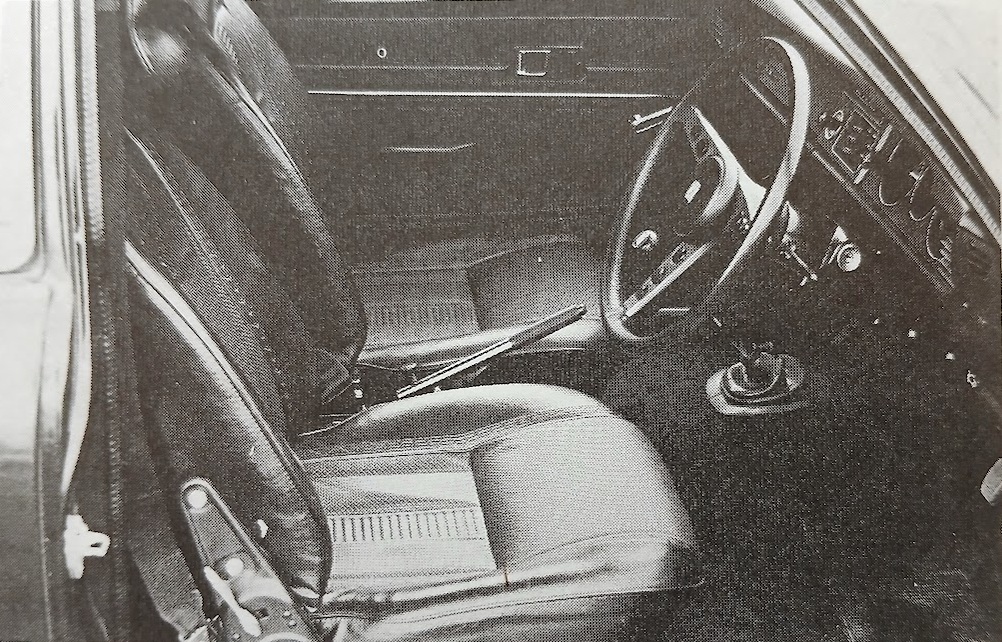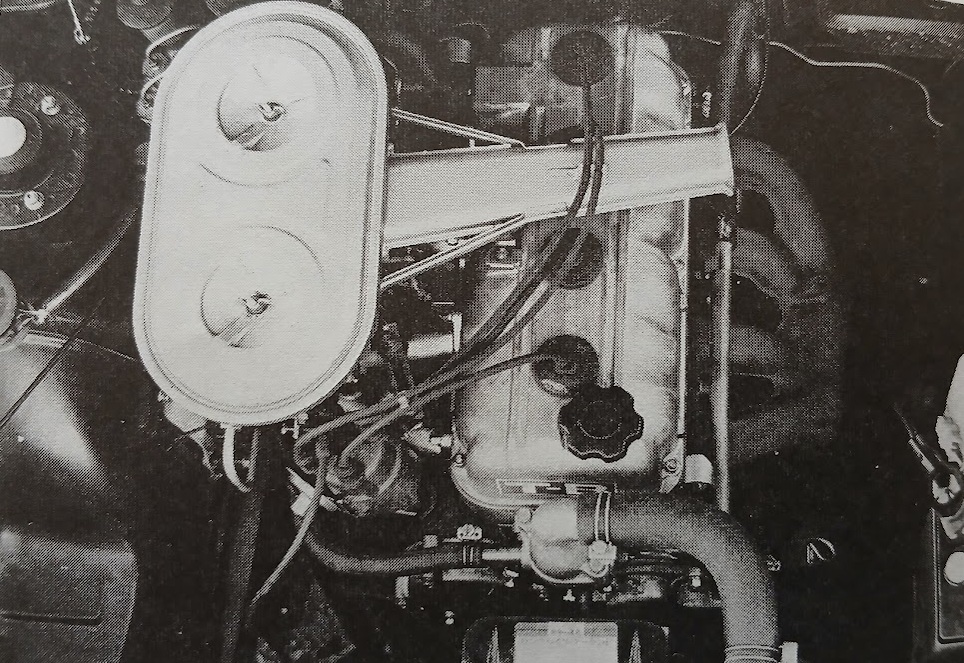Toyota Sprinter SR vs. Mitsubishi Colt Galant FTO GIII (1972)
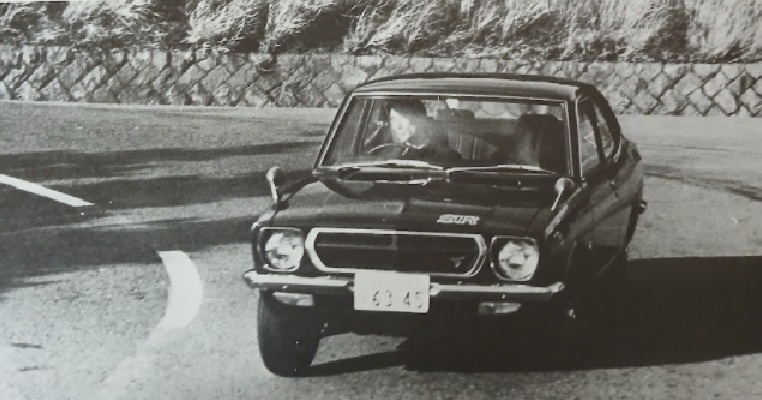
Publication: Car Graphic
Format: Group Test
Date: February 1972
Author: “C/G Test Group” (uncredited)
Comparison test: Toyota Sprinter SR vs. Mitsubishi Galant FTO GIII
This month, we compared two 1400cc sports cars, the Toyota Sprinter SR and the Mitsubishi Galant FTO GIII, under a variety of conditions, including performance testing at Yatabe. We would like to begin by briefly explaining why we chose these two models from the many cars in the same class. First, the Sprinter SR boasts the best specs in its class, making it a natural choice for pure motoring enthusiasts like us (and we think many C/G readers share our priorities), so we unanimously agreed that it should be included. Second, the Galant FTO GIII was just recently released on the market, and since we drove the GII last month and were impressed with its handling, we were particularly interested in how the GIII, which has 9ps more power, would stack up, so we included it as well. When we think of Sprinters, the Nissan Sunny GX also immediately comes to mind. In our opinion, however, the Sunny Coupe 1200GX is the best of the Sunny model range, and the Excellent, with its SOHC 1400cc engine, is a donwngrade in every respect (except for having a brake servo), so we deliberately left it out of this comparison test. To avoid any misunderstanding, we should add that the C/G test is first and foremost a test of driving performance, and places particular emphasis on the balance of maneuverability and braking power with power performance, especially when it comes to cars that are marketed as being sporty.
The Sprinter SR is currently the hottest of the Corolla series, having appeared in April 1971. It is only available as a two-door coupe; no four-door sedan version is offered, as in the SL, which uses the same engine. The crossflow OHV 1407cc engine has a compression ratio of 9.6 (or 8.5 on regular gasoline models) and twin carburetors, producing 95ps/6000rpm (91ps/6000 in the regular gas version) and 12.3kgm/4000rpm (12.0kgm/4000rpm). A key feature is that it comes standard with a 5-speed gearbox. Cars of this size and character with 5-speed gearboxes are very rare, even internationally, with the only other example we can think of being the Alfa Romeo 1300GT Junior. The suspension, with its ordinary MacPherson strut front and leaf-sprung rigid axle rear layout, is even stiffer than the SL’s, and the stabilizer is also thicker at 19mm in diameter. The performnce-focused SR comes with radial tires as standard equipment, but does not even have a radio, which is practically a given in domestic cars. It is priced slightly lower than the SL, at 644,000 yen.
While the basic design of the Sprinter SR dates back to the 1966 Corolla 1100 sedan, the Galant FTO, which was announced in October 1971, is much newer under the skin. With the exception of the engine, the powertrain and suspension are almost entirely carried over from the Galant 14/16L and GTO. Therefore, the FTO, which shares the same track width as those models, but has a 120mm shorter wheelbase and a body that is 150kg lighter, promises excellent handling from the start due to its wide-track proportions. The OHV 1378cc engine, a short-pushrod unit exclusive to the FTO, is basically an enlarged version of the old 11F/Colt 1200 series engine. In the GIII, the sportiest of the FTOs, this engine has a compression ratio of 9.5 and two Stromberg-type carburetors, producing 95ps/6300rpm and 12.3kgm/4500rpm. Apart from this engine tuning and the addition of a brake servo, the GIII is virtually identical to the GII. The base price of the GIII is 660,000 yen, but if you add the “mandatory optional equipment” (a strange term that reminds me of my college days) that came with our test car, such as 155SR-13 radial tires and a rear window defogger, the price comes to 682,000 yen, which is significantly more expensive than the Sprinter SR.
In terms of on-paper specs, these two cars could hardly be more similar. The engine output and torque figures are exactly the same, and vehicle weight is virtually identical, at 840kg for the SR and 835kg for the GIII, so the power-to-weight ratios are just fractions apart, at 8.84kg/ps and 8.78kg/ps, respectively. Both are fitted with 155SR-13 tires, and the final drive ratios are 4.30 for the SR and 4.22 for the GIII, so overall gearing is more or less the same. In fact, other than the GIII having a 4-speed gearbox, versus the SR’s 5-speed, the biggest difference between them is the shape of the body.
Power performance
The Sprinter/Corolla’s 1400cc engine, with its hemispherical combustion chambers and V-shaped valve arrangement, is well-known for its high-revving performance despite being an OHV. This is expecially true for the 95ps SR model, which, with its twin-carburetor setup, can be fully utilized up to the redline of 6500rpm. However, it is neither quiet or particularly smooth, and the noise level (mainly engine fan noise and exhaust resonance) increases dramatically above 3500rpm.
The SR’s greatest attraction is its 5-speed gearbox, whose gear ratios and final drive ratio are well matched to the engine’s power characteristics. This engine generates strong, relatively flat torque throughout its practical rev range from 1500 to over 6000rpm, meaning that the top three gears of the 5-speed gearbox have significant overlap in their operating ranges. For example, overaking acceleration from 60-100km/h, which is a common maneuver on the highway, can be accomplished in third, fourth, or fifth gear depending on the need and the driver’s mood. 60-100km/h in fifth gear takes 15.2 seconds, while in third gear it is a quick 7.2 seconds. The ratios of this 5-speed gearbox are quite Alfa-like, and the 0.861 overdrive fifth is not only a high-speed cruising gear, but can also be used frequently on slow Japanese roads. If you feel like it, you can use it from about 60km/h (about 2000rpm), and if you step on the throttle at 100km/h, it will accelerate decisively.
The shift pattern is the same standard international arrangement used by Alfa (Porsche finally changed to this pattern in 1972), with fifth gear located up and to the right. The gear lever is spring-loaded towards the third-fourth plane, so to shift down from fifth to fourth, you just pull it back gently and it goes into the fourth gear slot, making for quick and confident downshifts.
Acceleration is incredibly fast for a 1.4-liter engine, and the clutch and throttle are smooth, allowing for quick starts with very little wheelspin. The 0-400m time was 18.2 seconds. This was achieved by revving it up to exactly the 6500rpm redline; there is no point in pushing it any further because the torque drops off rapidly beyond that.
In the speed tests at Yatabe, the SR recorded a top speed of 163km/h in fifth gear (at 5600rpm), while the maximum in direct fourth was 151km/h (6450rpm). The speedometer was unusually accurate at 100k/h, and was a bit pessimistic at top speed, reading 159km/h. At the legal cruising speed on the highway, 100km/h, the engine is turning only 3500rpm in fifth gear, so the interior is relatively quiet. However, once you exceed 120km/h, the wind noise around the window frames suddenly becomes quite loud. Speaking of noise, the gearbox is also noisy, especially in second gear. Also, when you shift from fourth gear to overdrive fifth, the engine noise subsides, but a faint gear whine begins.
During the top speed test at Yatabe, the SR suffered a small mishap. The car suddenly lost power and our speed dropped, and upon investigation, it was found that one of the spark plugs had melted, causing a hole in the number 3 cylinder. From the beginning of the test, the car’s engine had been knocking when accelerating in high gears, even at around 3000rpm, and it exhibited a dieseling tendency where the engine would not stop even after the ignition was turned off. These were clear signs of trouble, and when we re-tested the car a few days later, both of these issues had been resolved. It is safe to assume that this was an accidental failure caused by insufficient maintenance.
As mentioned in the introduction, we tested the Galant FTO GII with a single Stromberg carburetor and 86ps in last month’s issue, and were very impressed by its quick-revving engine and excellent handling. However, the 95ps GIII we tested this time left a less satisying impression. It certainly revs up smoothly to its 6600rpm redline, but that was also true of the GII. The biggest detraction that dampened our enthusiasm was the noise. The engine fan became very noisy from around 5000rpm and above, and the differential was even noisier. It was especially bad under hard throttle, and as a result, the noise during acceleration in first and second gear was terrible, giving the impression that the car is much lower-geared than it actually is.
This differential seems to tbe the Achilles’ heel of the Galant series. Every Galant we have driven has had severe differential noise, and we had to replace the differential twice in the 46,000km (mostly in Tokyo) that we drove our long-term C/G 1300cc AI Custom sedan. On this point, we would like to take the opportunity to request that the manufacturer take immediate action.
The FTO GII’s 86ps was perfectly adequate for practical use, but it felt a bit underpowered for sporty driving on mountain roads. By comparison, the GIII is certainly more powerful, particularly in the stronger torque it provides between 3000 to 5000rpm, which is the most important range for practical use. This was most noticeable when climbing hills. On our usual test hill, the GII was almost always straining at the limit of 6600rpm in second gear, but the GIII was able to easily reach 80% of the same speed at 4500rpm in third. The strong mid-range torque was also demonstrated after the Sprinter’s breakdown at Yatabe mentioned above, when the GIII towed it back to Tokyo. Even in this situation, it was easy to drive at a steady 40 to 50km/h (2200-2800rpm), and the water temperature gauge did not change at all from normal.
The GIII’s top speed was 154km/h (at 6050rpm), which was a bit disappointing considering that GII also achieved a recorded speed of 150km/h (at 6250rpm, using 6.15-13 tires, slightly larger than radials).
The FTO’s key strength is its ease of driving, mainly due to its flexible engine and its light, easy-to-use clutch and gearbox. The pedals are ideally positioned, making heel-and-toeing a natural proposition. Shifting is light and precise, allowing for quick and satisfying operation. However, its standing-start acceleration times are spoiled considerably by poor rear axle location. While normal starts are no problem, abrupt, full-throttle starts cause the axle to tramp wildly, making clean getaways difficult. This is true of all Galants except the GTO MR, which is equipped with a torque rod. Because of this issue, the 0-400m time was 18.5 seconds, 0.3 seconds slower than the SR.
The gear ratios of the FTO’s 4-speed gearbox are a handicap when it comes to fast driving. The gap between third and top gear is particularly large, and when driving on the highway at 100km/h or more, we weren’t often tempted to downshift into third to overtake. Even though the engine is equipped with twin carburetors, its top-end power is not as strong as the low and mid-range power, so you won’t want to push it to high engine speeds. Given this characteristic, the current gear ratio seems a little too large. A smaller reduction ratio and lower engine speeds would improve not only the maximum speed, but also acceleration times. As it stands, the car is relatively under-geared.
Comparing the power performance of the two cars, the winner is clear. In terms of both absolute speed and acceleration, the SR is far superior. If we assume that the power is truly the same (both the output and the torque specs are identical, but subjectively the SR’s 95ps feels much more powerful), then the difference in top speed comes down to the advantage of the overdrive fifth gear. In any case, the fifth gear also reduces fuel consumption, noise level, and vibration during high-speed cruising, so it is preferable in practical terms as well. At least as far as the test cars are concerned, the SR has a wider effective engine rotation range, while the GIII struggles at the top end. Therefore, when the FTO is driven at 100 to 120km/h (which is now a common cruising speed on the highway, regardless of engine size), it effectively has only one forward gear, fourth, while the SR driver can choose between fourth or fifth gear at will, making acceleration and deceleration faster and with greater control.
In terms of standing-start acceleration, the 0-100km/h times for the SR and GIII are 13.2 and 13.9 seconds, which isn’t that great a difference, but the difference grows to 1.8 seconds in the 0-120km/h times (where both cars are at the limit of third gear), and there’s a huge gap of 8.1 seeconds between the cars from 0-140km/h, where the SR’s time is 30.5 seconds and the GIII takes 38.6 seconds. Since both cars are in fourth gear in the 120-140km/h range in this test, the results are purely a reflection of the difference in driving force each car offers at high engine speeds around 4800-5600rpm.
The overtaking acceleration data clearly shows that the SR has stronger torque across the entire rev range. It bears repeating that the tire diameter is the same for both cars, and the final drive ratio is virtually the same, 4.30 for the SR and 4.22 for the GIII. Looking at top gear acceleration in 40km/h increments, the SR takes 10.6 seconds to go from 40 to 80km/h, while the GIII takes 12.3 seconds, a difference of 1.7 seconds. When accelerating from 60-100km/h, the gap grows to 2.1 seconds, from 80-120km/h, it becomes 3.4 seconds, and it continues to widen from there. This doesn’t mean the SR’s engine is a high-speed type; its torque just holds up better than the FTO’s, even at low speeds, making it easier to use. This simply illustrates the difference in efficiency between the hemispherical combustion chamber and the wedge type.
Fuel economy
Both cars are equipped with twin two-barrel carburetors, and both have high compression ratios (9.6 for the SR, 9.5 for the GIII). Both require super-grade gasoline. We measured constant-speed fuel economy at 60km/h and 100km/h in top gear (both fourth and fifth gear, in the SR’s case). In fourth gear, at 60km/h, the SR returned 14.1km/l and the GIII returned 14.6km/l, while at 100km/h the SR returned 11/4km/l and the GIII returned 11.6km/l with the FTO being slightly better in both cases. However, in overdrive fifth gear, the SR returned even better results of 17.1km/l and 12.5km/l, respectively.
Practical fuel economy was recorded on a round trip from Tokyo to Hakone. On the Tomei Expressway, we made frequent use of the SR’s fifth gear, so we expected that it would probably outperform the FTO, but in the end, both vehicles averaged exactly 10.8km/l in a coincidental tie. The SR was undoubtedly better when cruising on the Tomei Expressway, but on the Hakone hill climb, we ended up unneessarily shifting between fourth and fifth just for the fun of it, which probably cancelled out its highway advantage. Both have a gasoline tank capacity of 45 liters.
Handling, ride comfort, and brakes
We drove the Sprinter SR with its standard 155SR-13 Bridgestone RD201 radial tires set to pressures of 2.0kg/2.0kg. The steering system is highly rigid, without the free play around the straight-ahead position that is a common problem with Toyota cars. The steering response is reasonably sharp and accurate. There is strong understeer in corners, but it is by no means excessive. When you lift your right foot in the middle of a corner, the car tucks quite strongly to the inside, a characteristics similar to front-wheel-drive cars (which tend to be quirky when pushed). The cornering grip of the RD201s is high, at least on dry pavement, and they rarely squeal. However, on surfaces less smooth than those on a circuit, the rear wheels have a tendency to hop, sometimes losing contact with the road momentarily and jumping sideways. Also, in tight corners, there is a lot of body roll despite the stiff springs, and the inside rear wheel tends to lift, resulting in severe wheelspin. The SR is at its best in a series of smooth, medium-speed corners at 80-100km/h. Roll is minimal in this kind of cornering, the transitions left and right are snappy and crisp, and the powerful third gear makes it extremely fast and fun to drive.
Road noise is well muted, and the harshness of the radial tires is not noticeable even on rough surfaces. The ride is certainly firm, with constant pitching and bouncing, especially at low speeds, but there is no bottoming or floating even on large disturbances such as bridges. In short, the ride is absolutely ideal for those who prefer this type of car.
The unservoed disc/drum brakes require a lot of pedal pressure regardless of speed, but they are very effective. The feeling is similar to using brakes with hard pads that are fitted with a servo, but the servo is not working. In practical terms, the SR’s brakes are really at the limit of what can be used without servo assistance. If it were our car, we would install one. There is remarkably little nose dive during sudden braking.
The Galant FTO GIII’s 155SR-13 Yokohama GT Special tires were also set to a pressure of 2.0kg/2.0kg, but to be honest, this suspension is better suited to a good quality bias-ply tire than a radial. This is because, first of all, the road noise isolation is not as good as it should be for a 1972 model, and the harshness of the radial tires is faithfully transmitted fo the body. Last month, when we drove the 86ps GII equipped with Yokohama Y205 bias-ply tires, I thought the FTO was a very quiet car, but this time, with the car on radials, our impression changed completely.
In terms of handling, the GII with bias-ply tires also felt much better balanced overall and easier to handle. It is true that the GIII with radials has much sharper (and, at the same time, much heavier) steering response, and the maxmum cornering speed is slightly faster. However, it is no exaggeration to say that the delicate balance between power and handling that existed in the GII is spoiled in the GIII with the power increase to 95ps and the switch to radial tires. We are curious to see what kind of handling the GIII would display if equipped with good bias-ply tires. Of course, we are talking about the car’s balance in extreme situations, and in normal high-speed driving, the GIII’s handling is perfectly fine. Understeer is moderate, and even if you back off the throttle in mid-corner, there is only a slight change in the car’s cornering attitude.
The FTO’s ride is much stiffer with radial tires than with bias-plies (the suspension settings are the same as the GII), but the ride is still not as stiff as in the Sprinter SR. The ride is very different between the front and rear seats, with reactions to bumps being much more violent in the rear.
The servo-equipped disc/drum brakes work powerfully with very little pedal pressure, and they have good feel. In start contrast to the Sprinter SR, we got the feeling they were using low-friction, “soft” pads designed for use without a servo, even though a servo is installed. We didn’t have the chance to perform our usual 0-100-0 fade test this time, but the FTO’s brakes felt as though they might fade if used harshly. The GII’s un-servoed brakes also felt light and powerful (though the master cylinder diameter is naturally different), so they probably use pads made of the same material. Note that the Sprinter uses single-cylinder calipers, while the FTO uses opposed-cylinder ones.
Interior and equipment
Both cars’ front seats have generously sized reclining backrests, allowing the driver to stretch their arms and legs out fully, like in a good sports car. The driving positions of both cars are so similar that you hardly notice the difference when switching from one to the other. The steering wheels in both cars are moderately low (the height of the FTO’s wheel can be adjusted) so they don’t obstruct the view, and the gauges are easy to read. The SR’s steering wheel is wrapped in real leather, while the FTO’s uses a clever imitation that resembles leather no matter how you look at it.
As for secondary controls, the horn buttons on the SR’s steering wheel spokes can be operated while holding the wheel, which is good, but in the FTO you have to push the pad in the center. The frequently used headlight on/off switch is located on the dash in both cars, and the SR’s push-pull knob is too far away when the driver has the three-point seat belt fastened. The FTO has a toggle switch, which is a little better, but we’d prefer to have everything controlled by a stalk on the steering column. The wiper/washer in the FTO is built into the turn-signal stalk, which is good. The SR has its wiper/washer switch on the dash, and unlike the light switch, you have to operate it with your left hand, which is inconvenient. The pedals in the FTO are positioned so that they are easier to operate with your heels on the floor. However, both cars make heel-and-toeing easy.
The SR offers better rear seat comfort. Two people can sit in a natural position in the rear of the SR, whereas in the FTO, the passengers’ knees will be tight against the front seatback unless the driver is small and the seat is moved forward.
In terms of heating and ventilation, the SR is much better. The controls are easy to operate and allow fine adjustments to the temperature. In contrast, the heater in the FTO offers either too much heat or none at all, with no fine adjustment in between, so you have to constantly fiddle with the lever all year round. Also, the on/off knobs for the face-level vents on both ends of the FTO’s dash are set far back on the panel, making them difficult to operate while driving. Overall, we have to say that the Toyota’s interior design is superior. As mentioned above, the SR has simplified equiment, and does not include a radio, lighter, or center console, but instead comes standard with radials and finned high-speed wipers. The FTO comes with more accessories, such as an AM radio, lighter, console, and so on, but the radials on our test car are a 16,000 yen option.
The trunks of both cars are deep but short, and their openings are relatively small. The spare tire is placed under the floor in both cars, so in the event of a flat tire, all the cargo must be removed. The Toyota comes with a much more complete tool kit, and the tools are of better quality. It includes a spanner set, an adjustable wrench, two screwdrivers, a spark plug wrench, pliers, a wheel wrench, and even a set of wheel chocks.
Instead of a summary of the test data, we would like to conclude by stating our personal preference. Given a choice between these two cars, we would undoubtedly take the Sprinter SR. Although these cars have the same 95ps output, the SR runs much more enthusiastically and intuitively, and it is simply more fun to drive, with the 5-speed gearbox being a major attraction. Moreover, the SR’s 644,000 yen price includes radial tires, whereas adding radial tires to the FTO GIII’s 660,000 yen base price raises the cost to 676,000 yen. In the FTO’s case, we would rather have the GII (608,000 yen), with single carburetor and bias-plies, which has a good balance between its power and chassis. While the SR is a tough car all-around, the FTO has a softer feel and will be more widely accepted. It is easier to operate and more compact than the SR, making it particularly suitable for use in the city. Its Ford Capri-like styling and newness on the market are also sure to be attractive qualities for many people.
Postscript: Story Photos
